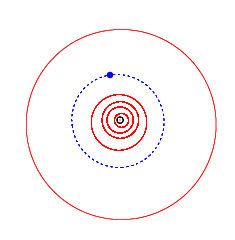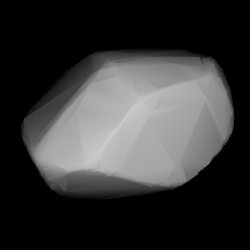Related Research Articles
2575 Bulgaria, provisional designation 1970 PL, is a stony Florian asteroid from the inner regions of the asteroid belt, approximately 7 kilometers in diameter. It was discovered on 4 August 1970, by Russian astronomer Tamara Smirnova at the Crimean Astrophysical Observatory in Nauchnyj, on the Crimean peninsula. It was named for country Bulgaria.

9968 Serpe, provisional designation 1992 JS2, is an asteroid from the middle regions of the asteroid belt, approximately 12 kilometers in diameter.
(9942) 1989 TM1 (provisional designation 1989 TM1) is a background asteroid from the central region of the asteroid belt, approximately 4.5 kilometers (2.8 miles) in diameter. It was discovered on 8 October 1989, by Japanese astronomers Nobuhiro Kawasato and Tsutomu Hioki at the Okutama Observatory (877) in Japan. The asteroid has a tentative rotation period of 3.1 hours.

1652 Hergé, provisional designation 1953 PA, is a stony Florian asteroid from the inner regions of the asteroid belt, approximately 9 kilometers in diameter. It was discovered on 9 August 1953, by Belgian astronomer Sylvain Arend at the Royal Observatory of Belgium in Uccle, Belgium. It was later named after Belgian cartoonist Hergé.
7655 Adamries, provisional designation 1991 YM1, is a Nysa asteroid from the inner regions of the asteroid belt, approximately 4 kilometers in diameter. It was discovered on 28 December 1991, by German astronomer Freimut Börngen at Karl Schwarzschild Observatory in Tautenburg, eastern Germany. It was named after mathematician Adam Ries.
3181 Ahnert, provisional designation 1964 EC, is a stony Flora asteroid from the inner regions of the asteroid belt, about 8 kilometers in diameter. It was discovered by German astronomer Freimut Börngen at the Karl Schwarzschild Observatory in Tautenburg, eastern Germany, on 8 March 1964.
2175 Andrea Doria, provisional designation 1977 TY, is a stony Florian asteroid from the inner regions of the asteroid belt, approximately 4 kilometers in diameter.
9115 Battisti, provisional designation 1997 DG, is a stony Vestian asteroid from the inner regions of the asteroid belt, approximately 5.5 kilometers in diameter. It was discovered on 27 February 1997, by Italian astronomers Piero Sicoli and Francesco Manca at Sormano Astronomical Observatory in northern Italy. The asteroid was named for Italian singer-songwriter Lucio Battisti.
3710 Bogoslovskij, provisionally known as 1978 RD6, is a rare-type asteroid from the central region of the asteroid belt, approximately 11 kilometers in diameter.

1683 Castafiore, provisional designation 1950 SL, is a carbonaceous background asteroid from the central region of the asteroid belt, approximately 21 kilometers in diameter. It was discovered on 19 September 1950, by Belgian astronomer Sylvain Arend at Royal Observatory of Belgium in Uccle, Belgium, and named after the character Bianca Castafiore from The Adventures of Tintin.
2080 Jihlava, provisional designation 1976 DG, is a stony Flora asteroid from the inner regions of the asteroid belt, approximately 6 kilometers in diameter. The asteroid was discovered on 27 February 1976, by Swiss astronomer Paul Wild at Zimmerwald Observatory near Bern, Switzerland. It was named after the Czech city of Jihlava.
11949 Kagayayutaka, provisional designation 1993 SD2, is a stony background asteroid from the outer region of the asteroid belt, approximately 23 kilometers (14 miles) in diameter. It was discovered on 19 September 1993, by Japanese amateur astronomers Kin Endate and Kazuro Watanabe at Kitami Observatory in eastern Hokkaidō, Japan. The asteroid was named after Japanese artist Kagaya Yutaka.
4822 Karge, provisional designation 1986 TC1, is a bright asteroid from the inner regions of the asteroid belt, approximately 4 kilometers in diameter. It was discovered on 4 October 1986, by American astronomer Edward Bowell at the Anderson Mesa Station of the Lowell Observatory in Flagstaff, Arizona. The asteroid was later named after American physics teacher Orville Karge.

1855 Korolev (prov. designation: 1969 TU1) is a stony Flora asteroid from the inner regions of the asteroid belt, approximately 7 kilometers in diameter. Discovered in 1969, it was later named after Soviet rocket engineer Sergei Korolev.
9165 Raup, provisional designation 1987 SJ3, is a stony Hungaria asteroid and exceptionally slow rotator from the inner regions of the asteroid belt, approximately 4.7 kilometers in diameter.
1513 Mátra, provisional designation 1940 EB, is a stony Florian asteroid from the inner regions of the asteroid belt, approximately 5 kilometers in diameter. It was discovered on 10 March 1940, by Hungarian astronomer György Kulin at Konkoly Observatory in Budapest, Hungary. It was later named after the Mátra mountain range.
1856 Růžena, provisional designation 1969 TW1, is a stony asteroid from the inner regions of the asteroid belt, approximately 6.6 kilometers in diameter. It was discovered on 8 October 1969, by Russian astronomer Lyudmila Chernykh at Crimean Astrophysical Observatory in Nauchny, on the Crimean peninsula. The asteroid was named after Růžena Petrovicova, staff member at Kleť Observatory.
9321 Alexkonopliv, provisional designation 1989 AK, is a carbonaceous background asteroid from the outer region of the asteroid belt, approximately 11 kilometers in diameter.
8815 Deanregas, provisional designation 1984 DR, is a Florian asteroid from the inner regions of the asteroid belt, approximately 4.5 kilometers in diameter. It was discovered on 23 February 1984, by Belgian astronomer Henri Debehogne at ESO's La Silla Observatory in northern Chile. The asteroid was named for American astronomer Dean Regas.
11441 Anadiego, provisional designation 1975 YD, is a stony background asteroid from the central region of the asteroid belt, approximately 7 kilometers in diameter. It was discovered on 31 December 1975, by Argentine astronomer Mario R. Cesco at the El Leoncito Complex in western Argentina. It was named in memory of Argentine political activist Ana Diego.
References
- 1 2 3 4 5 6 7 "JPL Small-Body Database Browser: 17473 (1991 FM3)" (2017-05-02 last obs.). Jet Propulsion Laboratory . Retrieved 26 June 2017.
- 1 2 3 "17473 (1991 FM3)". Minor Planet Center. Retrieved 6 September 2016.
- 1 2 "Asteroid 17473 Freddiemercury – Nesvorny HCM Asteroid Families V3.0". Small Bodies Data Ferret. Retrieved 27 October 2019.
- 1 2 3 Masiero, Joseph R.; Mainzer, A. K.; Grav, T.; Bauer, J. M.; Cutri, R. M.; et al. (November 2012). "Preliminary Analysis of WISE/NEOWISE 3-Band Cryogenic and Post-cryogenic Observations of Main Belt Asteroids". The Astrophysical Journal Letters. 759 (1): 5. arXiv: 1209.5794 . Bibcode:2012ApJ...759L...8M. doi:10.1088/2041-8205/759/1/L8. S2CID 46350317 . Retrieved 6 September 2016.
- ↑ "LCDB Data for (17473) Freddiemercury". Asteroid Lightcurve Database (LCDB). Retrieved 26 June 2017.
- ↑ "MPC/MPO/MPS Archive". Minor Planet Center. Retrieved 6 September 2016.
- ↑ "Freddie Mercury: Asteroid named after late Queen star to mark 70th birthday". BBC News. 6 September 2016. Retrieved 26 June 2017.
- ↑ "A shooting star leaping through the sky: asteroid named after Freddie Mercury on '70th birthday'". Telegraph. 5 September 2016. Retrieved 26 June 2017.